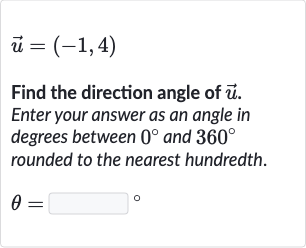Full solution
Q. Find the direction angle of . Enter your answer as an angle in degrees between and rounded to the nearest hundredth.
- Calculate Tangent: To find the direction angle of the vector , we need to calculate the angle that this vector makes with the positive x-axis. The direction angle, often denoted as , can be found using the arctangent function ( or ), which gives us the angle whose tangent is the ratio of the y-coordinate to the x-coordinate of the vector.
- Consider Quadrant: First, we calculate the tangent of the angle using the coordinates of . The tangent of is the ratio of the y-coordinate to the x-coordinate.
- Use Arctangent Function: Next, we use the arctangent function to find the angle whose tangent is . However, we must be careful with the signs and the quadrant in which the vector lies. Since the x-coordinate is negative and the y-coordinate is positive, lies in the second quadrant. The arctangent function will give us an angle in the fourth quadrant, so we need to add to get the angle in the second quadrant.
- Add °: We calculate the arctangent of using a calculator and then add to find the direction angle in the second quadrant.
- Round to Nearest Hundredth: We round the direction angle to the nearest hundredth as requested. (rounded to the nearest hundredth)
More problems from Inverses of sin, cos, and tan: degrees
QuestionGet tutor help
QuestionGet tutor help
QuestionGet tutor help
QuestionGet tutor help
QuestionGet tutor help
QuestionGet tutor help
Question
. Find the value of in degrees.Write your answer in simplified, rationalized form. Do not round.____
Get tutor helpQuestionGet tutor help

